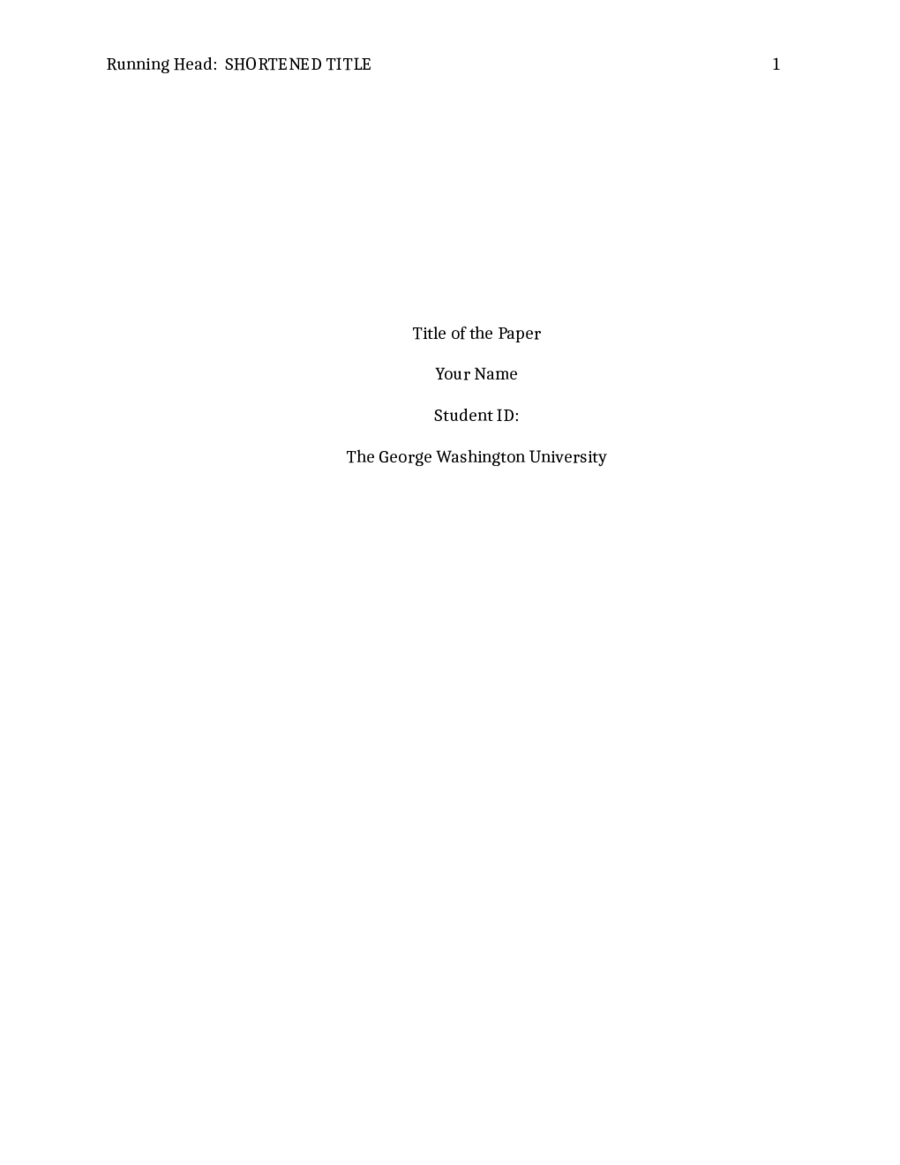Fillable Printable Apa Sample Title Page
Fillable Printable Apa Sample Title Page

Apa Sample Title Page
Running Head: SHORTENED TITLE 1
Title of the Paper
Your Name
Student ID:
The George Washington University
SHORTENED TITLE 2
Title of the Paper
Begin your paper following a few simple APA rules, pages 228-231. Always include a
title page with the required information, including a running head and page numbers
beginning with Arabic 1, which will be seen on all subsequent pages.
Begin your paper by indenting paragraph. Notice everything is double-spaced. No
more, no less. Also, notice that my font is the same everywhere, 12 pt and Times New
Roman or Arial only. No bold, no underline, etc. If you use headings within your paper you
will need to follow APA for that. If you only use one level of headings, you will follow the
following format.
Tips
The APA manual, 6
th
edition, should be purchased and followed for every paper. If
you use more than one level of heading, see page 62. If you use seriations, see pages 63-64
for rules on bulleted and numbered lists. There are rules for numbers—when to spell out
and when not to spell out. Punctuation rules, capitalization rules, hyphenation rules, and
most everything else can be found. Do not forget to follow format for citations, pages 169-
179, and reference page, pages 37, 49-51, and 180-192. On the reference page, do not
forget that hanging indents should be used, double-spacing continued, and references must
be listed in alphabetical order. In addition, please note the differences between books,
journals, papers, web addresses, and other resources referenced. Finally all works cited
must be found on the reference page, and all references must have a citation in the body of
the paper.
Plagiarism is inappropriate and is in direct violation of the honor code of The George
Washington University. Please follow quoting and paraphrasing rules found on pages 170-
SHORTENED TITLE 3
171. If citing a direct quote, “the citation must have author name, publication year, and page
number(s)” (Judge, 2011, p. 343). Please take note of the placement of the period after the
citation. Also, if the quote is 40 words or more, follow the rules for block quotes. When
paraphrasing, only cite the author and publication date (Judge, 2011). Be sure when
paraphrasing, that you are actually paraphrasing and not mostly quoting; this would be
considered plagiarism if caught.
Next Heading
Continue paper. Particularly in short papers, headings are not usually required. If
purchase the APA 6
th
edition manual and you follow these simple APA rules, you will always
earn full APA points on assignments requiring APA, write better, and completely impress
your professors, maybe even enough to earn an A because your classmates probably didn’t
follow APA.
SHORTENED TITLE 4
Reference Page
Glickman, C., Gordon, S. & Ross -Gordon, J. (2010). Supervision and instructional
leadership: A developmental approach (8th Edition). Boston: Pearson Education,
Inc.
Judge, D. (2011). How to write APA style: It’s easy (1
st
Edition). Boston: Happy Inc.
Reinke, S. (2003). Does the form really matter? Leadership, trust, and acceptance of the
performance appraisal process. Review of Public Personnel Administration, 23(1), 23-37.
doi:10.1177/0734371X02250109
Reitzug, U. C., West, D. L., & Angel, R. (2008). Conceptualizing instructional leadership: The
voices of principals. Education and Urban Society, 40(6), 694-714.
doi:10.1177/0013124508319583
Robinson, V., Lloyd, C., & Rowe, K. (2008). The impact of leadership on student outcomes:
An analysis of the differential effects of leadership types. Educational Administration
Quarterly, 44(5), 635-674. doi:10.1177/0013161x08321509
Rowe, B. (2000). The influence of teacher efficacy and readiness for self-directed learning on
the implementation of a growth-oriented teacher performance appraisal process. Paper
presented at the meeting of the Annual Conference of the American Educational Research
Association. New Orleans, LA. Retrieved from
http://www.eric.ed.gov/PDFS/ED444942.pdf

SHORTENED TITLE 5
Sergiovanni, T. (1966). Satisfaction and dissatisfaction of teachers, final report. Retrieved July
15, 2010, from
http://www.eric.ed.gov/ERICDocs/data/ericdocs2sql/content_storage_01/0000019b/80/38
/ad/14.pdf
Singer, M., & Coffin, T . (1996) . Cognitive and volitional determinants of job attitudes in a
voluntary organization . Journal of Social Behavior & Personality, 11 (2), 313-328 .
Steensma, H., & Visser, E. (2007). Procedural justice and supervisors' personal power bases:
Effects on employees' perceptions of performance appraisal sessions, commitment, and
motivation. Journal of Collective Negotiations, 31(2), 101-118. doi:10.2190/CN.31.2.a.
Taylor, M., Tracy, K., Renard, M., Harrison, J., & Carroll, S. (1995). Due process in performance
appraisal: A quasi-experiment in procedural justice. Administrative Science Quarterly,
40(3), 495-523.
Tucker, P. D., & Stronge, J. H. (2005). Linking teacher evaluation and student learning.
Alexandria, VA: Association for Supervision and Curriculum Development.



